
What follows comes from Dr. Ryan Burge.
Who?
He teaches at Eastern Illinois University where he is an Assistant Professor of Political Science. His research primarily focuses on the interaction of religiosity and political behavior, hence his Twitter stream is full of some amazing statistical insights.
What you will discover, if you follow him on Twitter, is a fascinating flow of statistics. Some of these are quite surprising. So regardless of what you might, or might not, believe, what the data itself reveals can be quite a revelation.
Let’s jump in.
Below are five examples that throw back the curtain to reveal that things are often not how we might assume them to be.
Item 1 – The Decline of White Christianity
Let’s start with something you might already be aware of. Christianity is in decline.
The twist here is that this is a chart that specifically measures the percentages of just white people.
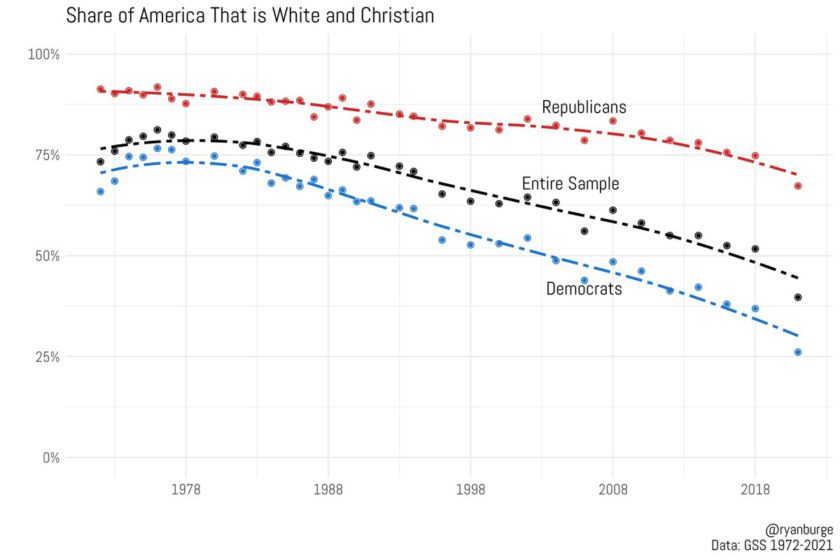
This decline of Christianity amongst those that are white is not political. Note that we can see it dropping off for both Dem and Rep. Also note that this is a decline that has been happening since the late 70s, it is not new and so it is not about Trump.
Well yes, what is perhaps the very best argument against Christianity these days is the actual behavior of the Trump-loving crowd, but that aside, the ongoing decline goes back many decades.
In 1972,
- 73% of Americans were white Christians.
- 66% of Democrats were white Christians.
- 91% of Republicans were white Christians.
Almost half a century later, in 2021, things have really changed …
- 40% of Americans were white Christians.
- 26% of Democrats were white Christians.
- 67% of Republicans were white Christians.
One other key point here is that now is not the end-game, that curve will most probably continue downwards. We are in the middle of a huge ongoing religious demographic shift.
What is going on?
The percentage who now reject traditional Christianity and identify as a “None” is rapidly rising. If curious about the details of that then Pew has the insights into that …
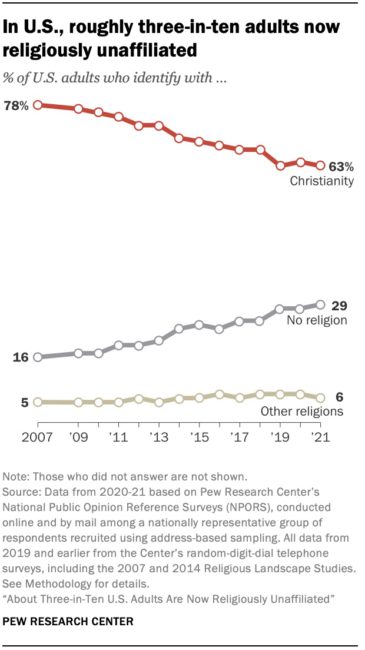
Item 2 – Large Numbers of Christians don’t actually Go to a Church at all
We have this fascinating breakdown …
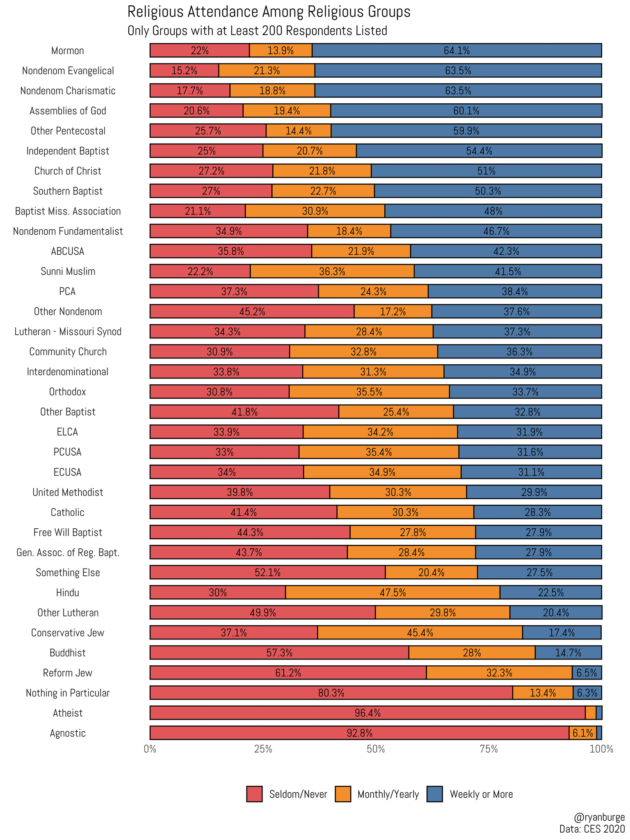
In the above, it is just the blue measure that identifies those that actually attend a place of worship on a weekly basis.
Surprises:
- Vast swathes of those who embrace a religious identity don’t actually go to any church.
- Interestingly enough, second from the bottom, we discover that there is a small slice of Atheists who do go to church weekly. My best guess on that is that they go to simply be with a partner who does believe.
Item 3 – Where people really stand in the Abortion Debate
This is quite frankly a huge surprise for me.
First, a quick preliminary on how to interpret the chart. What is rather obvious is that all the numbers don’t add up to 100%. That’s because what you have below in “Red” or “Blue” measures those who hold to that specific position. Those who selected neither stance are the rest. For example, about 50% of LDS at the bottom.
Surprise – very large percentages of many groups that are supposedly opposed, are actually pro-choice. For almost every group, except the last two, more than 50% support choice. Even for those last two, those are not tiny fractions but translate into literally millions of people.
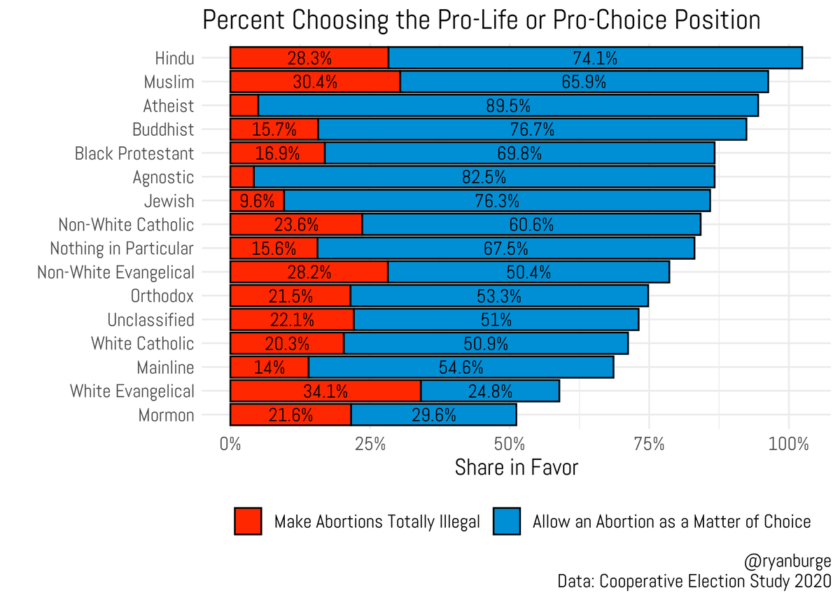
What is truly fascinating about all of this is that if you look back, you can see that things were once, not too long ago, very very different.
As late as 1991, there was no substantive difference between Democrats and Republicans on abortion. Since then: Dems are more supportive in cases like “poverty”, or just “wants no more kids”. Reps are less supportive for “rape”, “mother’s health”, and “serious defect”.
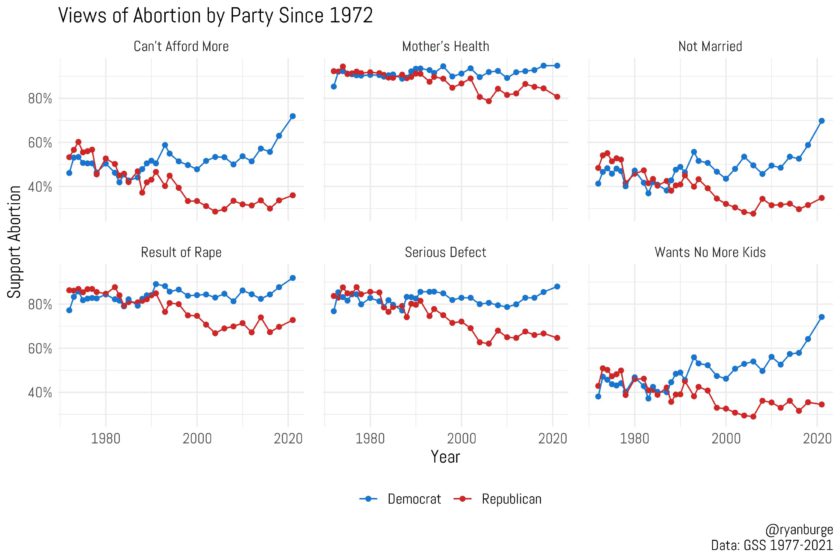
Since we are on the topic, let’s go a bit deeper. Now here is another big surprise. Slice up the evangelicals who do support abortion by age and this chart emerges …
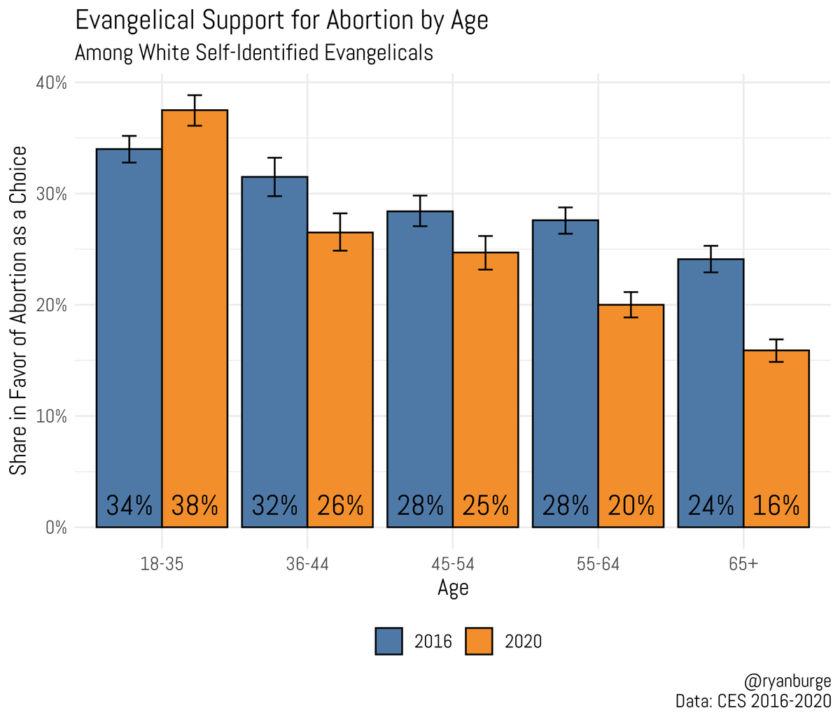
The younger an evangelical is, the more probable it is that they will support abortion. In fact, look at the 18-35 age group and you can see that support for abortion increased between 2016-2020.
The older an evangelical is the more probable it is that they are opposed.
What this tells us is that in the decades ahead, as the older individuals pass away, they will be replaced by far more tolerant individuals.
Item 4 – Confidence in the integrity of the 2020 election
When asked and answered, this is how the answers look when broken down by religion …
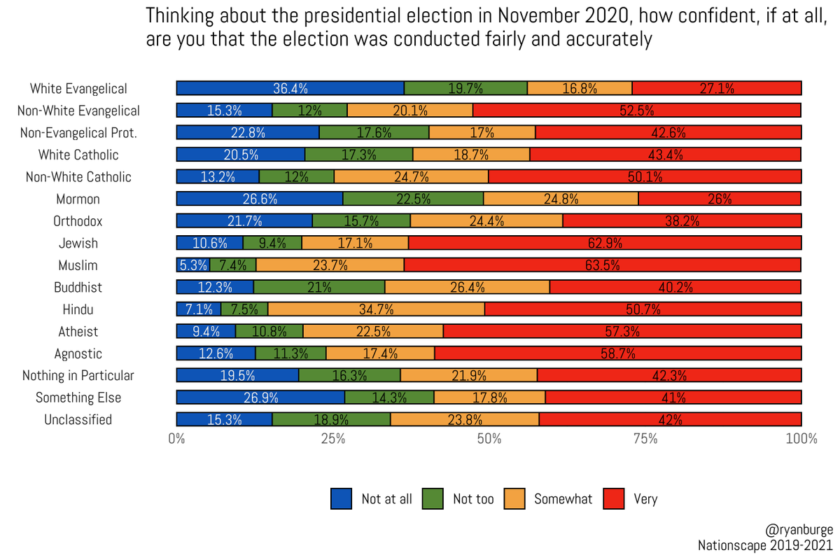
When somebody tells you that they are “Evangelical”, your immediate thought these days is to interpret that. We know that roughly about 80% of them voted for Trump as a response to him pandering to their beliefs, so you might assume that they are a Trump-supporting individual who buys into the big lie.
Look at the above.
27.1% of them are very confident that the 2020 election was solid. Another 18.8% are confident in the result to a high degree. That’s a total of 45.9%
As for the rest … well yes, I know, we do indeed have vast numbers of people who are indeed seriously stupid.
Item 5 – Breaking down the Religious demographics by age
We know generally the total percentages of those within different beliefs.
Here now is an interesting twist on that. What happens if you break down the percentages by age?
This …
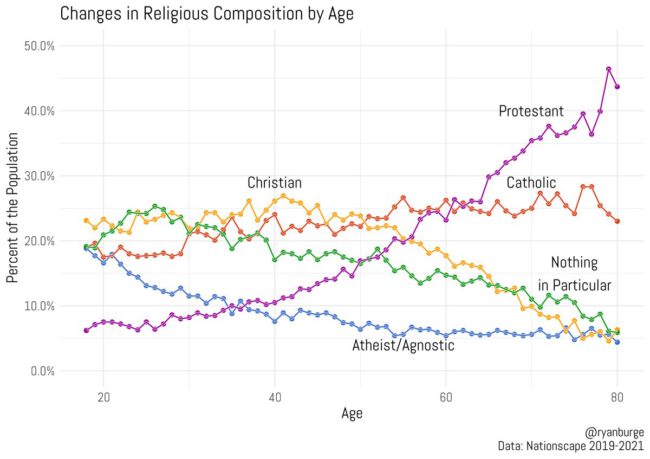
The “Catholic” curve is more or less flat. It tends to bend upwards a bit, so over time as older people pass away, Catholicism will probably decline by percentages that reflect that curve.
Nones and Atheist/Agnostic are generally younger. This is perhaps due to them being less invested in existing traditions and hence are more willing to let go of those.
What is weird is that downwards curve marked “Christian”. If you have a chart that records both “Catholic” and also “Protestant”, then what exactly does “Christian” mean? My guess is that many younger people don’t actually understand what the word “Protestant” means, hence opted for that, and older people do, so opted for “Protestant”. If correct, then the actual data truth here should be a merger of “Protestant” and “Christian”. That would result in a less stark curve upwards, which to be honest, feels a tad more reasonable.
Final takeaway – if people being asked survey questions don’t actually understand what is being asked, then the results will be misleading. The actual wording can alter results.
One last Observation
The above is just a sample of information I gleaned from Ryan’s Twitter feed in just this month (January 2022). It is not everything, there was rather a lot more. It simply consists of a few items that caused me to pause, think, and even modify my thoughts a bit.
Hat Tip to Ryan and others for the hard graft behind it all. If you also found it interesting then you might be interested in following him on Twitter (his Twitter feed is here).
This is where some might have this thought – “you might indeed say all this and promote him, but this is just some atheist professor with an ax to grind about religion.”
Actually no.
I have one more surprise for you.
What might not be so well-known or appreciated is that Ryan is not only a University Professor and author of many peer-reviewed studies, he is also a pastor in the American Baptist Church, and has served in that role within his current church for the past 14 years.
This is not a story about him and his views, but rather is a story about us, all of us, and what the empirical data reveals. That’s the real story.
Sometimes when the loudest voices shout we can end up with a skewed view of what is going on. Insights from data like this can help to correct that.
People as individuals are complicated. Once single term such as “Catholic”, or “Atheist” can never be the whole story. When we hear such terms it is easy to make assumptions. The problem is that doing that creates a false narrative, one that divides.
In the end, it is not “them” and us. It is just lots of diversity amongst us.
“If a nation expects to be ignorant and free, in a state of civilization, it expects what never was and never will be.”
Thomas Jefferson
